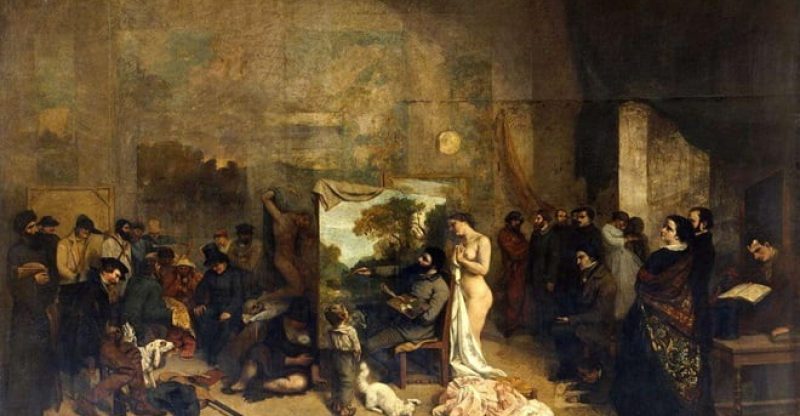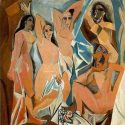Gustave Courbet’s The Artist’s Studio Analysis
Gustave Courbet, a prominent 19th-century French realist painter, left an indelible mark on the art world with his iconic masterpiece, “The Artist’s Studio (The Painter’s Studio).”
Gustave Courbet‘s bold and candid portrayals of everyday life set him apart as a visionary artist, and one of his most iconic works, “The Artist’s Studio,” stands as a testament to his artistic brilliance and unyielding spirit.
In the heart of this masterpiece lies a captivating narrative, unfolding within the confines of a studio space. Painted in 1855, during a profound social and political upheaval in France, “The Artist’s Studio” encapsulates Courbet’s defiance against the prevailing artistic norms.
The painting serves as a visual manifesto, challenging conventional artistic representations and societal expectations.
In this blog post, we delve into the profound analysis of this painting, exploring its artistic brilliance, historical context, and enduring significance. Join us as we unravel the layers of meaning behind this celebrated artwork.
Gustave Courbet’s The Artist’s Studio (The Painter’s Studio)
Historical Context of The Artist’s Studio
“The Artist’s Studio” was created by Courbet in 1855, a period marked by significant political, social, and artistic changes in France.
The mid-19th century was a time of transition from Romanticism to Realism and the onset of the Realist movement, of which Courbet was a leading figure. The painting was exhibited at the Paris Salon of 1855, and its unveiling coincided with a turbulent period in French history, characterized by political unrest and the aftermath of the 1848 Revolution.
Courbet’s choice to portray himself at work in the studio, surrounded by a diverse cast of characters, was a departure from the conventional subject matter of academic art. The academic art establishment favored historical, mythological, or allegorical scenes, and Courbet’s painting challenged these norms by presenting a contemporary and realistic scene from everyday life.
Understanding Gustave Courbet’s “The Artist’s Studio”: A Deep Dive into Creative Genius
“The Artist’s Studio” is a monumental canvas that captures the essence of a bustling art studio in the mid-19th century. Courbet’s gloomy, vertiginous studio is all at once an allegory, a manifesto, and a social satire.
Gustave Courbet meticulously constructs the composition, balancing figures, objects, and architectural elements to create a harmonious yet dynamic scene. The studio space, filled with artists, models, and onlookers, becomes a microcosm of the art world, reflecting the diverse facets of creativity and critique.
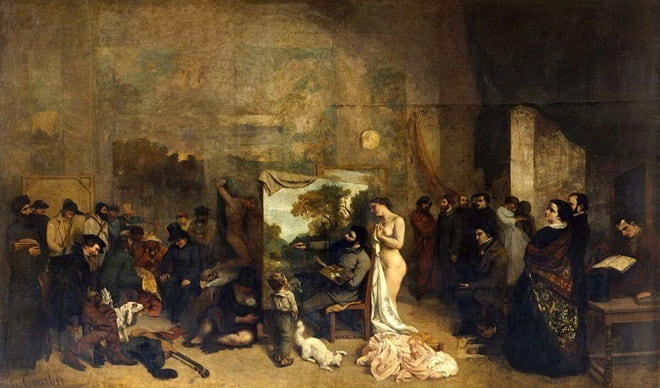
The Artist’s Studio, 1854-1855 by Gustave Courbet – The Musée d’Orsay in Paris, France.
Courbet’s realist approach is evident in the meticulous attention to detail and lifelike representation of his subjects. Unlike the romanticized depictions common in art during his era, Courbet portrays the ordinary with extraordinary precision. His ability to capture the nuances of human expressions and the play of light and shadow adds depth and authenticity to the painting, making it a testament to his mastery of realism.
Allegories and Symbols in Gustave Courbet’s The Artist’s Studio
“The Artist’s Studio” is rich in allegorical symbolism. Courbet strategically places symbolic elements throughout the composition, such as the painting of a nude woman, representing Truth, which is contrasted with an allegorical figure of Lies. This juxtaposition emphasizes Courbet’s commitment to truthfulness in art, challenging idealized representations prevalent in academic painting of the time.
1- Truth vs. Lies
One of the prominent allegorical elements in “The Artist’s Studio” is the contrast between Truth and Lies.
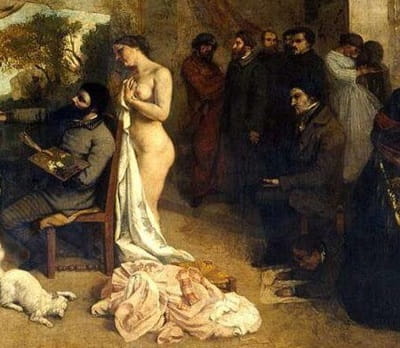
Truth vs. Lies in Gustave Courbet’s The Artist’s Studio.
In the painting, Courbet includes a nude female figure symbolizing Truth, standing confidently and unapologetically. This figure is juxtaposed with a crouching, sinister-looking figure representing Lies. This stark contrast highlights Courbet’s commitment to portraying reality as it is, without the idealized and embellished depictions common in academic art. By placing Truth at the center of the composition, Courbet champions the importance of honesty and authenticity in art.
2- The Painter’s Palette and Brushes
In the foreground of the painting, Courbet includes his palette and brushes, highlighting the tools of the artist’s trade. These objects symbolize creativity, craftsmanship, and the act of artistic creation.

The Painter’s Palette and Brushes in Gustave Courbet’s The Artist’s Studio Painting.
The palette, covered in vibrant colors, signifies the artist’s palette of emotions and ideas, ready to be translated onto the canvas. By prominently featuring these tools, Courbet emphasizes the tangible and hands-on nature of artistic expression, underscoring the artist’s direct engagement with the creative process.
3- The Boy
The boy to the left of the artist is also a reference. The smallest of the three central figures, he looks up to Gustave Courbet’s creation with admiration.
One hazard is a guess that he might represent innocence, or the desire to ‘un-learn’ the rules of academicism.
‘Paint the truth’ is what Courbet habitually said. The artist himself sits at a curious angle, painting an easel depicting Ornans, the landscape he knew best and from which he originally hailed.
It’s the single brightest area in the painting, a gleaming patch of outdoor light that illuminates everything else and through which Courbet appears to be almost half-emerging like a doorway. A doorway opening onto what exactly? The Future? Realism?
The boy is unsullied by the illusions of adulthood—he sees the truth of the world—and he represents an important goal for Courbet—to unlearn the lessons of the art academy.

The boy in Gustave Courbet’s The Artist’s Studio Painting.
The sophistication of urban industrial life, he believed, distanced artists from the truth of nature. Above all, Courbet sought to return to the pure, direct sight of a child. The cat, by the way, is often read as a reference to independence or liberty.
4- Characters in the Painting
The painting features a diverse array of characters, each representing a specific role within the art world.
Artists, models, patrons, and critics coexist within the studio space, illustrating the intricate web of relationships in the artistic community. Courbet’s inclusion of this varied cast challenges hierarchical distinctions in art, promoting a more inclusive and egalitarian vision of the artistic process. Each character embodies different perspectives and experiences, reflecting the multifaceted nature of artistic inspiration and interpretation.
The entire, rather crowded canvas, is divided into two large groups of people. In the group on the left, we see fairly rough types described. They are a cast of stock characters: a woodsman, the village idiot, a Jew, etc. There are several other allusions, such as the inclusion of the current ruler of France, Louis-Napoléon, but let’s focus on the theme at hand. Here then, are the country folk whom Courbet faces.
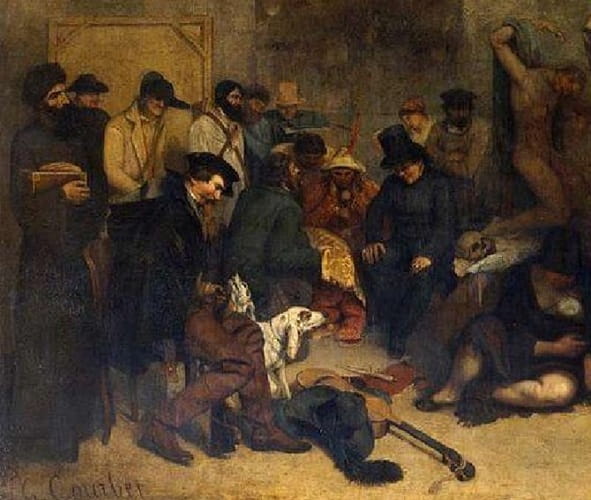
Characters in the left side of The Artist’s Studio Painting.
On the right side of the canvas is, in contrast, a far more handsome and well-dressed group. Gathered at the lower right corner of the painting are Courbet’s wealthy private collectors and his urbane friends.

Characters in the right side of The Artist’s Studio Painting.
In the painting’s extreme lower right sits Charles Baudelaire author of Les Fleurs de Mal, the influential poet who was a close friend of the painter.
5- Gustave Courbet may have been referring to Michelangelo’s Last Judgment
The composition seems directly related to the traditional composition of the New Testament story, the Last Judgment.
Think of Giotto’s Last Judgment fresco on the back wall of the Arena Chapel in Padua (1305-06), or Michelanglo’s Last Judgment painted on the far wall of the Sistine Chapel (1534-42).

Michelanglo’s Last Judgment was painted on the far wall of the Sistine Chapel (1534-42)
In those early paintings, the blessed (those that were on their way to heaven) were on the right side of Christ (our left), and the damned (those on their way to Hell) were shown on Christ’s left (our right).
6- Proudhon is in Gustave Courbet’s The Artist’s Studio Painting
The bearded figure standing towards the back, looking out at us is Pierre-Joseph Proudhon, the anarchist who famously said ‘property is theft’.
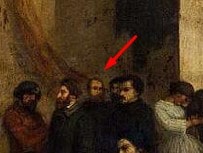
Proudhon is in Gustave Courbet’s The Artist’s Studio Painting.

Portrait of Pierre Joseph Proudhon, 1865 by Gustave Courbet.
7- Chamfleury is in Gustave Courbet’s The Artist’s Studio Painting
Seated on a stool is the scowling figure of Chamfleury, an art critic and close friend of the Honore de Balzac.

Chamfleury is in Gustave Courbet’s The Artist’s Studio Painting.

Portrait of Chamfleury, 1855 by Gustave Courbet.
These cameo appearances are instantly recognizable from earlier works by Courbet, to the extent that some of them would appear almost identical to their equivalent painted portraits.
These are people from Courbet’s social circle, early supporters of his anti-academicism and drive towards painterly ‘realism’. One could go as far as to say this is Courbet’s ‘side’, the ally of his artistic career.
8- Emperor Napoleon III
On the left side of the painting, we see a group of less handsome, less well-dressed individuals who would appear to represent everyday life.
They are dressed in the common attire of beggars, farmers, undertakers, paperboys, carnies, and other modes of plebian drudgery. In a time when the arts were growing increasingly political, Courbet’s manner of representing the peasant class had given many of the cultural nomenclature pause for concern.
The popular flavor of his paintings suggested something approximating the democratic, perhaps even the socialistic. However, upon closer inspection, one can see that the peasants in Courbet’s Studio are not proles but thinly disguised portraits of the ruling elite.
Emperor Napoleon III, for example, is represented at the front, dressed as a poacher. He had seized power in an illegal coup and was in the process of running the country as a dictatorship where none were allowed to openly criticize the government bosses.

Gustave Courbet’s ‘The Painter’s Studio’, detail of poacher.
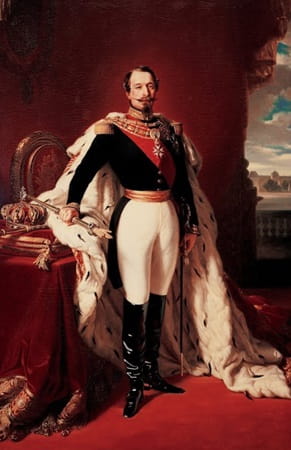
The Emperor Napoleon III, 1853 by Franz Xaver Winterhalter.
Scattered around the emperors’ feet are a jumble of items including a lute and a dagger. Common motifs within the genres of salon painting at the time. They are the iconography of academicism.
Impact on Artistic Movements
1- Realism
“The Artist’s Studio” is considered a quintessential work of Realism, a movement that emerged as a response to the romanticized and idealized depictions prevalent in academic art.
Courbet, along with other Realist artists, sought to represent the world as it truly was, focusing on ordinary people and everyday scenes. The painting’s rejection of idealized beauty and its emphasis on the raw, unembellished reality set the tone for the Realist movement.
2- Challenging Academic Norms
Courbet’s decision to paint himself in the studio, surrounded by various figures from the art world, was a direct challenge to the traditional hierarchy of subject matter in art.
Instead of conforming to academic ideals, Courbet celebrated the act of painting itself and the diverse individuals who contributed to the artistic process. This challenged established norms and contributed to the democratization of art.
3- Political Undertones
The inclusion of political figures such as Pierre-Joseph Proudhon and the red flag in the painting reflects Courbet’s political convictions.
Proudhon was a socialist philosopher, and the red flag was a symbol associated with revolutionary movements. Courbet’s decision to infuse political themes into his artwork aligned with the socio-political climate of his time, emphasizing the interconnectedness of art and broader societal concerns.
In conclusion, Gustave Courbet’s “The Artist’s Studio” remains a compelling subject of artistic analysis and admiration. Its intricate symbolism, historical context, and enduring legacy make it a rich source of inspiration for art lovers and scholars alike. By exploring the depths of this masterpiece, we gain valuable insights into the evolution of art and the boundless creativity of the human spirit.
References:
- https://smarthistory.org/courbet-the-artists-studio/
- https://www.gustave-courbet.com/the-artists-studio.jsp
- https://en.wikipedia.org/wiki/The_Painter%27s_Studio
- https://www.khanacademy.org/humanities/becoming-modern/avant-garde-france/realism/a/courbet-the-artists-studio-a-real-allegory-summing-up-seven-years-of-my-artistic-and-moral-life
- https://en.wikipedia.org/wiki/File:Last_Judgement_(Michelangelo).jpg
- https://www.automachination.com/gustave-courbet-allegory-studio/
- https://artsandculture.google.com/asset/the-emperor-napoleon-iii/SAH0-A5LXQbdEg?hl=en-GB
- https://en.wikipedia.org/wiki/Category:Paintings_of_Napoleon




